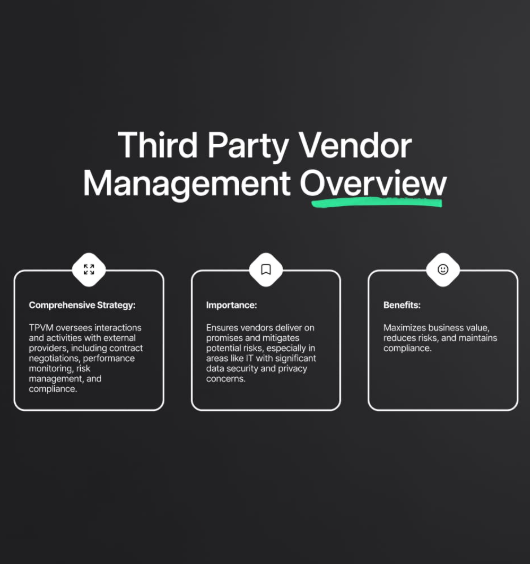A Complete Guide to Third-Party Vendor Management Software for Effective Supplier Risk Management

Supplier risk management is essential for businesses looking to minimize disruptions and ensure their vendors align with company standards. Third-party vendor management software, including tools like TPRM (Third-Party Risk Management) solutions and risk assessment platforms, plays a crucial role in simplifying these tasks, enhancing efficiency, and reducing risks.
In this guide, we will explore the importance of third-party vendor management software and review top tools and platforms that help with supplier risk management.
What is Third-Party Vendor Management Software?
Third-party vendor management software is a digital tool designed to help organizations manage and assess external vendors by providing capabilities for risk evaluation, monitoring, and compliance tracking. These platforms enable businesses to effectively assess, monitor, and manage suppliers throughout their entire lifecycle.
Key Features of Vendor Management Software
- Risk Assessment Tools: Evaluate supplier risks such as financial stability, compliance, and operational performance.
- Compliance Monitoring: Ensure vendors meet legal, regulatory, and ethical standards.
- Contract Management: Simplify contract creation, approval, and renewals.
- Performance Analytics: Measure vendor performance to identify areas for improvement.
- Automation: Streamline repetitive tasks like document collection and risk scoring.
Benefits of Vendor Management Software
Adopting vendor management software offers various advantages for organizations:
- Enhanced Risk Management: Tools like risk assessment platforms help identify vulnerabilities in the vendor network.
- Improved Compliance: Software ensures that vendors meet necessary standards, reducing the risk of non-compliance and legal consequences.
- Centralized Data Management: Vendor data is consolidated into one platform, making access and decision-making easier.
- Cost Efficiency: Automated workflows save time and reduce manual effort, making resource allocation more effective.
Understanding TPRM Tools and Solutions
What are TPRM Tools?
Third-party risk management (TPRM) tools are designed to assess, identify, and reduce risks associated with third-party vendors. These tools help maintain operational continuity and protect sensitive business data.
Key Features of TPRM Software:
- Dynamic Risk Scoring: Risk levels are assigned to vendors based on real-time data.
- Incident Management: These tools track and resolve risk-related incidents quickly.
- Customizable Dashboards: Offer insights into vendor risk trends and key performance indicators (KPIs).
- Predictive Analytics: These tools forecast potential risks based on historical data.
Top TPRM Solutions:
- Third-Party Risk Management Platforms: Comprehensive tools for managing large vendor networks.
- Risk Assessment Tools: Focused platforms that evaluate specific risks.
- Vendor Risk Software: Combines compliance monitoring and performance tracking.
How to Implement Vendor Risk Management Software
To effectively implement vendor risk management software, follow these steps:
- Define Objectives: Identify the goals for using vendor management software, such as enhancing compliance or improving risk monitoring.
- Evaluate Features: Choose tools that meet your organization’s specific needs, like automated workflows or predictive analytics.
- Integrate Systems: Ensure the software seamlessly integrates with other tools, such as ERP or procurement platforms.
- Train Stakeholders: Provide training for relevant team members to maximize the software’s potential.
- Monitor Effectiveness: Use performance metrics to assess how well the software is meeting your objectives.
Comparing Vendor Risk Assessment Tools
Vendor risk assessment tools focus on evaluating potential supplier risks, helping businesses maintain a robust and resilient supply chain.
Key Features of Vendor Risk Assessment Tools:
- Scoring Systems: Rank vendors based on their risk profiles.
- Automated Reporting: Generate comprehensive reports on supplier risk.
- Compliance Checks: Ensure adherence to industry standards and regulations.
- Continuous Monitoring: Track changes in vendor performance over time.
Vendor Risk Management vs. Supplier Risk Management Tools
While both tools focus on mitigating risks, vendor risk management software centers on vendor compliance and cybersecurity, whereas supplier risk management tools often cover a broader scope, including logistics and operational performance.
Choosing the Right Vendor Risk Management Solution
When selecting a vendor risk management solution, consider the following:
- Scalability: Ensure the software can handle your current and future vendor base.
- Integration Capabilities: Choose a platform that integrates with your existing tools, such as ERP or procurement systems.
- Usability: Look for user-friendly platforms with intuitive workflows.
- Customer Support: Select a provider offering strong support services, including training and troubleshooting.
The Advantages of Third-Party Risk Management Platforms
Third-party risk management platforms provide end-to-end solutions for managing vendor risks. These platforms bring together multiple tools like risk assessment, compliance monitoring, and incident management into one integrated system.
Benefits of TPRM Platforms:
- Real-Time Monitoring: Stay updated with insights into vendor performance and risks.
- Custom Reporting: Tailor reports to meet organizational needs.
- Collaboration Features: Facilitate communication between internal teams and vendors.
The Role of Vendor Risk Management Companies
Vendor risk management companies specialize in helping organizations implement and optimize risk management strategies. They provide expertise in areas such as:
- Identifying vulnerabilities in vendor networks.
- Customizing risk management solutions.
- Providing ongoing support for risk management platforms.
Future Trends in Vendor and Supplier Risk Management
- AI Integration: AI-powered tools will enhance risk identification and predictive analytics, improving risk evaluations and decision-making.
- Focus on ESG (Environmental, Social, Governance) Metrics: As businesses prioritize sustainability, ESG factors are becoming increasingly important in vendor assessments.
- Blockchain for Transparency: Blockchain technology can provide secure, transparent tracking of vendor compliance and performance data.
Conclusion
Third-party vendor management software is a crucial tool for organizations to manage supplier risks effectively. By utilizing solutions like TPRM tools, risk assessment platforms, and vendor risk software, businesses can streamline vendor management processes, ensure compliance, and mitigate potential risks.
Investing in the right software ensures that businesses can maintain operational resilience, foster strong vendor relationships, and succeed in an increasingly complex business environment. By embracing the latest technology and best practices in vendor risk management, organizations are better equipped to handle emerging challenges with confidence.


 English
English 












































































































































































































































































































































































